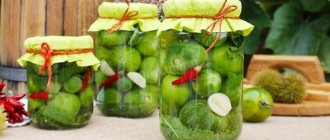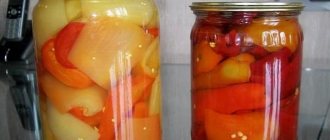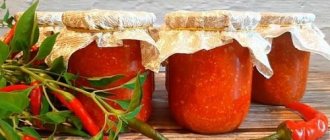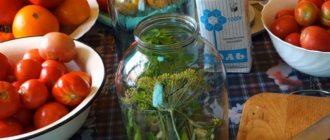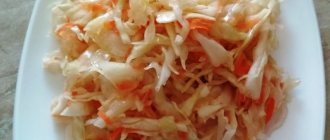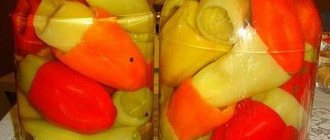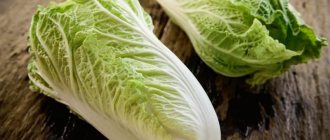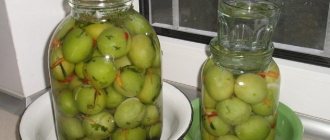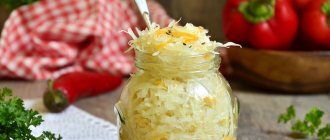Pickled hot pepper
A home-cooked vegetable will be an excellent preparation for the winter. The spicy seasoning will improve the taste of any dish and will be a useful addition to the festive table. A large number of different preparations can be prepared from hot peppers.
Tsitsak is extremely beneficial for the body. Salting and pickling vegetables allows you to preserve vitamins and nutrients, so this spicy addition will be especially appropriate during the winter period of colds.
A spicy vegetable must be chosen correctly for winter preparation:
- Each pod should be fairly dense without any damage.
- The stalk of the vegetable should not be shriveled.
- The thinnest small pod has the most pungency.
- The skin of the pod should not have any brown spots.
- When salting as a whole, the stalk is not cut off.
To pickle peppers, be sure to remove seeds. When preparing the vegetable as a whole, it is recommended to pre-soak it in cold water to remove excessive pungency. Before salting, prick the peel with a fork. This is done so that the piquant taste of the fruit is preserved, but unnecessary bitterness is removed.
You can also salt or pickle peppers in pieces. During the cooking process, they will acquire a certain shade, become soft and acquire the desired taste.
Armenians prepare pepper in several ways, so you can choose any suitable recipe for preparing it. Preparing peppers will not take much time; preparing pickles does not require any special culinary skills or knowledge.
Armenian hot salted peppers can be stored for a long time. When fermented, it is not rolled up, but prepared and stored in barrels or jars under a plastic lid. Some chefs recommend keeping the pepper for 1-2 days in advance so that the vegetable wilts slightly, and only then proceed with the ferment.
Kvasim as follows:
- Wash the vegetable and prick it with a fork.
- Pour 5 liters of cold water into a 10 liter bucket.
- Pour 15 tbsp into the container. spoons of salt.
- Place 2 heads of garlic and 3-4 bay leaves in a container.
- Add cherry leaves, dill and coriander.
- Place 1 kg of chili pepper.
- Cover the bucket with oppression and do not touch the container for 14 days.
After 2 weeks, the oppression is removed. The pepper should be placed in glass jars, which must first be sterilized. You should definitely add all the spices from the brine that remains in the bucket to the jars.
Pour the brine into a saucepan and place on the stove over low heat. Bring the brine to a boil and pour the hot brine into jars with pepper. The containers are screwed on with lids and set aside until completely cooled.
You can store pickled hot peppers in the refrigerator or pantry; the pickled vegetable does not lose its taste.
Pepper Tsitsak: characteristics and description of the variety
Pepper Tsitsak: photo of the variety
Tsitsak pepper is a variety of pepper, and in translation from Georgian “tsitsak” means “pepper”. Like many representatives of this vegetable crop, the variety is the result of selection, with the only difference being folk selection. In Armenia and Georgia, dishes made from this pepper are included in the daily diet; it is consumed pickled, salted and pickled.
Hot pepper of the Tsitsak variety loves heat and its cultivation in areas with a temperate climate is possible only in greenhouse conditions. If natural conditions allow planting peppers in open ground, then you should choose a well-lit area so that no trees or shrubs block the light, creating shadow. Tsitsak is a very sun-loving pepper.
- This variety is characterized by high keeping quality, good yield, and is slightly susceptible to diseases.
- Externally, the hot pepper Tsitsak is very similar to the well-known type of pepper - chili, also being a type of hot pepper. However, in terms of spiciness, Tsitsak pepper is still significantly inferior to chili, and also has a pleasant sweetish taste, which is why it is often used in canning and various preparations.
- The plants, like most peppers, develop in the form of bushes and have a medium degree of leaf cover. The stem is strong, the foliage has a characteristic oblong shape with a pointed edge. The height of the Tsitsak pepper variety can reach one meter.
- The shape of the fruits of the Tsitsak bitter pepper is cone-shaped, and the length is quite impressive - 15-20 cm. The peppers have juicy, fleshy pulp. When fully ripe, pepper fruits are rich red in color, while slightly unripe ones are light green.
Pepper in marinade
The pickled vegetable will please everyone at home if it is prepared correctly. The vegetable is saturated with the characteristic taste of the marinade, becomes moderately spicy, but does not burn. There are several recipes for pickled hot peppers:
Pepper in a special marinade
You will need:
- 1 kg hot pepper;
- 0.5 l of wine vinegar;
- 0.5 l sunflower oil;
- 250 g garlic;
- 1 bunch of celery leaves;
- 2 bunches of cilantro;
- salt.
The pepper must be green in color, but has reached its maturity. Wine vinegar gives the appetizer a special piquant note, so it should be included in the marinade. Culinary experts do not recommend replacing wine vinegar with table vinegar. Required ingredients are cilantro and celery. Greens give the preparation a special aroma and characteristic taste, enhance the nutritional value and supplement the dish with useful substances.
To prepare, take 7 liters of cold water, add wine vinegar, salt and vegetable oil to the liquid. Place the marinade on the stove over low heat and wait until it boils. During this time, the vegetable is peeled and washed, the greens and garlic cloves are finely chopped.
Pepper is placed in a boiling marinade. It takes no more than 5 minutes to cook the pepper.
Stand away from the pan so as not to inhale the spicy smell when preparing pickled peppers.
Cook the vegetable until it acquires a yellowish tint. The vegetable is carefully transferred from the pan to a colander, and at this time the greens are added to the marinade. It is recommended to add some red bell pepper. Boil the liquid for another 5 minutes.
Place the vegetable in sterilized jars, pour in the marinade with pieces of garlic and bell pepper. All ingredients should be laid in layers - hot peppers, herbs, garlic, bell peppers. We alternate layers.
Next, the filled jars are sterilized in boiling water under the lid for 20 minutes, after which they are sealed with lids using a seaming machine.
Classical
The second classic recipe for pickled peppers is more familiar to housewives. In it, wine vinegar is replaced with a 9% table product.
For the marinade take:
- 8 spoons of sugar;
- 200 ml. 9% vinegar;
- 1 kg. hot pepper;
- 1 l. water;
- any spices;
- 3 tablespoons salt.
Prepared peppers and spices are placed in sterilized jars. Pour boiling water over the products and leave for 15 minutes. Next, the water is poured into a saucepan and the marinade is prepared over the fire - sugar, vinegar and salt are added to the liquid.
The contents of the container are poured with hot marinade; it can be rolled up without sterilization. The jars are turned over and wrapped in a warm blanket. After complete cooling, the workpiece is transferred to the pantry.
Pickled peppers with honey
The beekeeping product gives the spicy vegetable a special piquant taste. The dish turns out rich, sweet-spicy and aromatic.
For preparation take:
- 2 tablespoons honey;
- 1 tablespoon apple cider vinegar 6%;
- 1 tablespoon salt;
- hot peppers.
Before adding food, the jar is sterilized and the lid is boiled. The tails of the pods are cut off and the peppers are placed vertically in a jar. Honey should be thoroughly mixed with vinegar and added to hot water to prepare the marinade. Pour it over the peppers in the jar and cover with a nylon lid. After a week, the pepper is ready to eat.
Features of pickling hot peppers in Georgian
The cuisine of the peoples of the Caucasus is famous for canned products, which are flavored with spices, aromatic herbs, and hot peppers.
A special feature of preparing hot peppers for the winter is that you need to be careful when pickling the fruits. The surface of the peppers is so hot, and the juice, if it gets on your hands, can corrode the wounds and cause irritation. It is better to salt while wearing gloves, otherwise the burning juice will inadvertently get on the mucous membranes of the eyes, nose, mouth and cause a burning sensation and a severe allergic reaction.
Vegetable pods of different colors are prepared. Here the hostess herself chooses which varieties will be in the jar with the marinade. The main thing is that the peppers are thin and long, so they marinate better. Large specimens are also suitable for slicing.
You can add 1-2 pieces of bell pepper if there is not enough heat. Cherry tomatoes go well together in one jar with hot pods.
Pickled peppers should be rolled in the same way as other fruits. The product will be better preserved in a sterilized jar under a metal lid.
Peeing
You can prepare a soaked vegetable for winter storage. Soaking has been a popular method of preserving many foods in the past. In the old days, people soaked any berries, apples, and vegetables. Today, this method has been replaced by preservation with vinegar or quick salting, which is familiar to all housewives.
When soaking the vegetable, keep it in the cold, not in a warm place. The aging period is 4-6 weeks. Only after this the vegetable will be ready for consumption and long-term storage. To fill, prepare a weak salty solution; you can add a little dry currant to taste.
Place garlic, dill and pepper in a saucepan. The ingredients are poured with ready-made cold brine. All ingredients must be covered with liquid. Place the pan under pressure. Ready peppers have a yellow tint.
Comparison with similar varieties
Tsitsak pepper is most similar to chili. Both crops are a type of hot pepper. At the same time, Tsitsak is characterized by a reduced level of spiciness when compared with chili. It has a moderately sweet taste. Therefore, the fruits of the plant can be used for salads and pickled.
Hot pepper Tsitsak is considered a popular plant variety characterized by excellent productivity. For the cultivation of a crop to be successful, it needs to be provided with quality care.
Salting
The vegetable can be pickled with corn leaves or use the classic pickling recipe. To prepare the vegetable, you can cut it into pieces or leave it whole. When canning, it is better to leave the stalk in its entirety, so that it is easier to pick up the vegetable when consuming it.
For preparation you will need:
- 1 kg hot pepper;
- dill;
- 7 cloves of garlic;
- 5 liters of water;
- 1 glass of salt.
Salt must be dissolved in water, but do not put the liquid on fire. Place garlic and chopped dill in the container. Add pepper and press down with pressure. Leave under pressure for 3 days in a warm place.
To pickle vegetables with corn leaves:
- 70 g salt;
- 1 l. cold water;
- 1 kg. vegetable;
- dill with umbrellas;
- corn leaves and silk;
- Bay leaf;
- garlic;
- celery.
Place corn leaves and greens in a suitable bowl. We alternate peppercorns with garlic, celery leaves, and bay leaves.
Cover each layer with dill. Greens will give the preparation a piquant taste and aroma.
Prepare the brine - dissolve the salt in cold water, then pour in the workpiece. The jars should be placed in a warm place for 1 week. When the brine brightens, put the peppers in sterilized jars, drain the brine, boil and pour hot into the container. Seal the jars with hermetically sealed lids. The preparation will last all winter if you place it in a cool place.
Lecho
For 3 people we will need:
- Hot pepper – 0.5 kg.
- Tomatoes – 1 kg.
- Garlic – 1 head.
- Parsley – 100 gr.
- Salt – 50 gr.
- Sugar – 50 gr.
- Vinegar – 40 gr.
KBZHU for the entire product / per 100 g:
- Kcal – 1422.1/98.7;
- Fats – 98.5/6.8;
- Carbohydrates – 117.7/8.2;
- Proteins – 16.2/1.1.
Cooking time – 3 hours.
Preparation method:
Tip: You should choose vegetables that are as fresh and ripe as possible so that they don’t get crushed in your hands.
- If you wish, you can take tsitsak and add chili pepper for taste.
- Chop the tomatoes and grind in a blender. It can be replaced with a meat grinder.
- Pour the puree into a saucepan, pour in the oil and simmer for about 8 minutes.
- We cut off the tails of the pepper and add it to the tomato paste. Pepper and salt.
- Place the garlic, passed through a press, into the pan.
- Finely chop the greens and add them afterwards.
- Add vinegar and mix thoroughly.
- Cook for another 5 minutes and you can marinate in prepared jars. They must be filled to the top.
- Wrap in a blanket and cover with sterile lids. Leave until completely cool.
- We roll it up and store it in the basement or cellar.
Yandex.Pictures
Salty tsitsak with Georgian herbs
Georgian tsitsak is one of the main dishes of many Caucasian peoples, without which not a single feast is complete. This recipe requires the following ingredients:
- 3 kg hot pepper;
- six cloves of garlic;
- a bunch of dill, parsley;
- 5 liters of cold water;
- mixture of spices of Georgian cuisine;
- 200 grams of salt.
The peppers do not need to be washed; they are left on the table to dry under the scorching sun. Then pierce each vegetable with a fork several times on each side so that the marinade gets inside and the fruit does not float up during marinating. Dissolve all the salt in a large container of clean cold water. Place all the herbs, peppers and garlic on the bottom of a large saucepan and pour over the prepared cold marinade.
Place the weight on the pot of pepper so that the vegetables can stand in a warm place for several days and soak in a saline solution. After the specified time has passed, take out the paprika, squeeze it out of the marinade and place it in sterilized jars, prepare a new brine and fill the containers to the neck, close the lids and put in the refrigerator. When storing in a pantry or cellar for a long time, jars of pepper must be additionally sterilized in boiling water for 15 minutes.
- Lightly spicy, moderately bitter tzatziki peppers are perfect for this recipe and will be very spicy when cooked.
- The temperature in the room where peppers are cooked, pickled or stored is very important. The temperature must be high enough for rapid fermentation. And for storage it should be low so that the jars do not break.
- This pepper is perfect for borscht, couscous or other dishes as a snack.
Tsitsak in Armenian for the winter in a cold way
You can recognize pickled peppers with your eyes closed by their smell. Marinating hot peppers with sourness according to this recipe is a godsend for spicy lovers. Preparation will take 15 minutes, and the result will delight you all winter.
Snack products:
For 2 jars of 0.5 l:
- hot pepper - 400 gr;
- vinegar 9% - 400 ml;
- sugar - 260 gr
Energy value: 60 kcal
Cooking time: 15 min.
Servings: 8.
Step-by-step recipe for Armenian winter snacks:
- To make cold-process chili peppers, prepare the products according to the list.
- Rubber gloves are put on, the pepper is washed and the tails are cut off. Punctures are made along the entire vegetable using a toothpick.
- Clean, sterilized jars are filled quite tightly with pepper.
- Sugar is added and distributed in equal parts between jars (130 g each).
- Vinegar is poured to the top and the lids are closed.
- The jars are turned over 5-6 times to completely dissolve the sand.
- After a few months, capsicums prepared in this way can be eaten.
Bon appetit!
Yandex picture
